Reviving Dignity: The Remarkable Perseverance of Myanmar’s Displaced
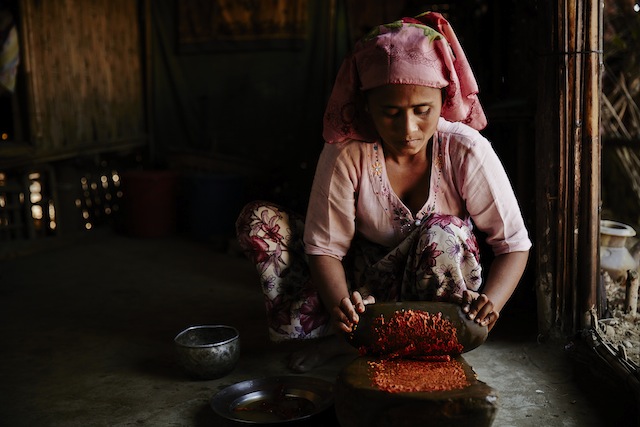
SITTWE, Myanmar, May 12 (IPS) - In Myanmar's Western Rakhine State, over a hundred thousand people displaced by inter communal violence that broke out nearly three years ago remain interned in camps on torrid plains and coastal marshes, struggling to survive.
In the face of unimaginable hardship, many have found ways to cope and maintain their dignity, through innovation and hard work.
Behind sensational and at times gory headlines peddled by the mainstream media, a far more simple story is unfolding: the story of scores of victims of violence in camps for internally displaced people (IDPs) outside the Rakhine State capital, Sittwe, gaining sustenance, acquiring fuel for fires, re-establishing businesses, and developing community-led social services.
Inter communal violence erupted in 2012 between the region's majority Rakhine Buddhists and minority Muslims who mostly self-identify as Rohingya, an ethnic label that remains heavily contested and at the heart of a decades-old conflict.
Three years later, over 140,000 IDPs, predominantly Rohingya Muslims, remain effectively interned and segregated in camps from which the government has not allowed them to return home.
Aid is administered through United Nations agencies and other mainstream bodies that are bound to work primarily with the government, leading to top-down interventions that do little to build the capacity of beneficiaries themselves, at worst stifling their ability to take their lives back into their own hands.
Up against the odds, these communities are nevertheless demonstrating the sheer strength of the human spirit, and the remarkable resilience that often presents itself only in the darkest, most hopeless situations. Through small acts of determination, courage and kindness, they are assuring their own survival and slowly regaining their dignity.
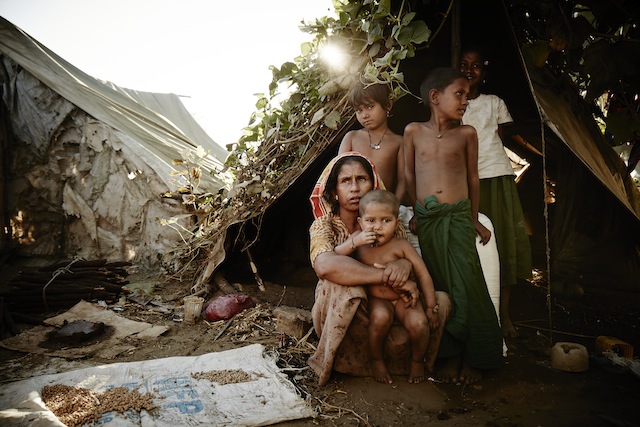 Arafa lives in this tent with her six children and three grandchildren. When she fled her burning home she had nothing but her longyi (traditional skirt) and one shirt so has begun growing gourds on the tent for extra sustenance. Her grandchildren photographed here all wear beads that were blessed by the local mullah. Credit: Courtesy Rob Jarvis
Arafa lives in this tent with her six children and three grandchildren. When she fled her burning home she had nothing but her longyi (traditional skirt) and one shirt so has begun growing gourds on the tent for extra sustenance. Her grandchildren photographed here all wear beads that were blessed by the local mullah. Credit: Courtesy Rob Jarvis
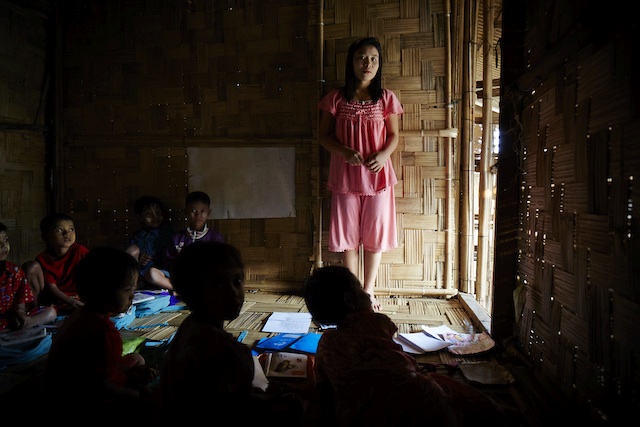 Chu Mar Win, a Rakhine Buddhist IDP in her early twenties whose house was burned down by Rohingya Muslims in July 2012, volunteers as a teacher in her camp. To ensure the young children can stay in school, the community all donate some rice and small amounts of money so she can afford to keep teaching. Credit: Courtesy Rob Jarvis
Chu Mar Win, a Rakhine Buddhist IDP in her early twenties whose house was burned down by Rohingya Muslims in July 2012, volunteers as a teacher in her camp. To ensure the young children can stay in school, the community all donate some rice and small amounts of money so she can afford to keep teaching. Credit: Courtesy Rob Jarvis
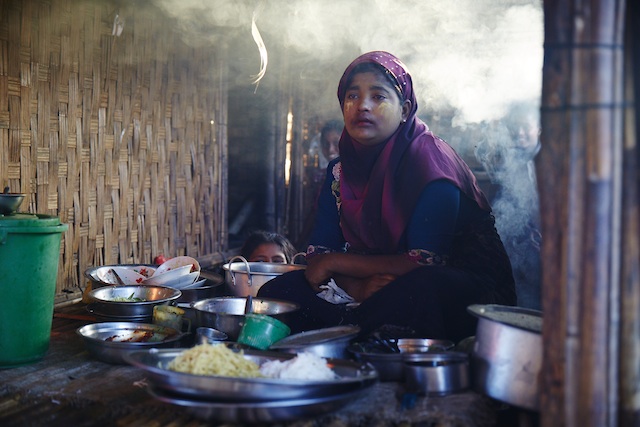 Zadi Begum, a 25-year-old single mother of five, runs a small noodle shop out of the front of her hut. As she fled her village in July 2012 with her mother and children, her husband, 30-year-old Ibrahim, stayed behind to collect some things but was killed by Rakhine Buddhists with a machete. She struggled to raise the roughly 27 dollars needed to buy the basic tools and materials to start her noodle shop. Credit: Courtesy Rob Jarvis
Zadi Begum, a 25-year-old single mother of five, runs a small noodle shop out of the front of her hut. As she fled her village in July 2012 with her mother and children, her husband, 30-year-old Ibrahim, stayed behind to collect some things but was killed by Rakhine Buddhists with a machete. She struggled to raise the roughly 27 dollars needed to buy the basic tools and materials to start her noodle shop. Credit: Courtesy Rob Jarvis
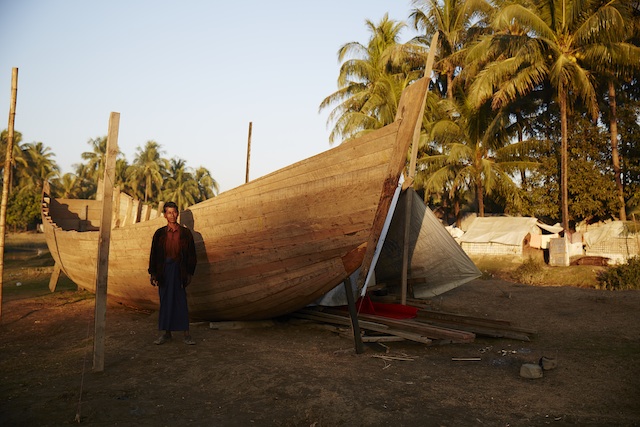 Three years ago, in July 2012, Noor Ahmed had his boat stolen by Rakhine Buddhists in his village of Myo Thu Gyi. Now, he and his 13-year-old son, both IDPs, work tirelessly on other people's boats for daily wages. He stands before one such boat that the pair has been working on for 20 days. Credit: Courtesy Rob Jarvis
Three years ago, in July 2012, Noor Ahmed had his boat stolen by Rakhine Buddhists in his village of Myo Thu Gyi. Now, he and his 13-year-old son, both IDPs, work tirelessly on other people's boats for daily wages. He stands before one such boat that the pair has been working on for 20 days. Credit: Courtesy Rob Jarvis
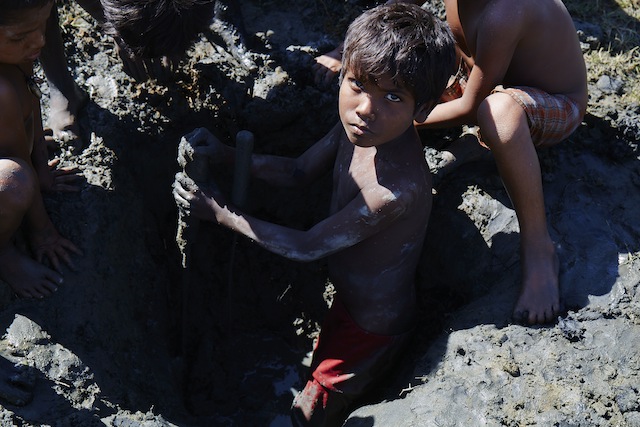 Mohammed Hussain, aged eight, spends his weekends in the mud with friends looking for buried pieces of wood that can be salvaged for fuel. Here, he has been at work with his three brothers and two friends for four hours, and they have found a single piece that he is excited to take home to his mother. Credit: Courtesy Rob Jarvis
Mohammed Hussain, aged eight, spends his weekends in the mud with friends looking for buried pieces of wood that can be salvaged for fuel. Here, he has been at work with his three brothers and two friends for four hours, and they have found a single piece that he is excited to take home to his mother. Credit: Courtesy Rob Jarvis
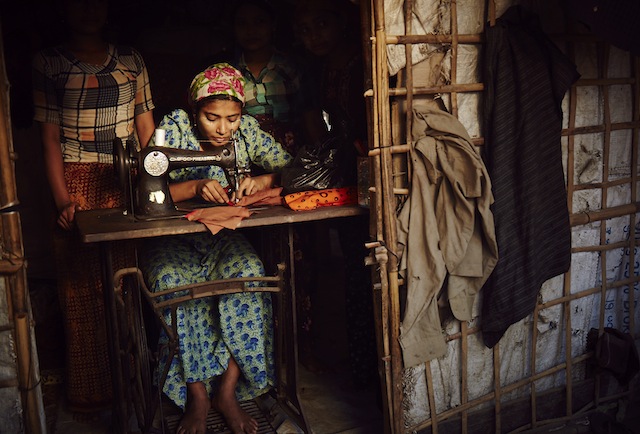 La La May is making a blouse, catching the last minutes of sunlight through her doorway. She provides training to other girls here and makes between fifty cents and one dollar per day by tailoring clothes. She currently has four female students who she teaches for free using this single sewing machine, which they bought from the ‘host community', locals from the neighbouring village. Credit: Courtesy Rob Jarvis
La La May is making a blouse, catching the last minutes of sunlight through her doorway. She provides training to other girls here and makes between fifty cents and one dollar per day by tailoring clothes. She currently has four female students who she teaches for free using this single sewing machine, which they bought from the ‘host community', locals from the neighbouring village. Credit: Courtesy Rob Jarvis
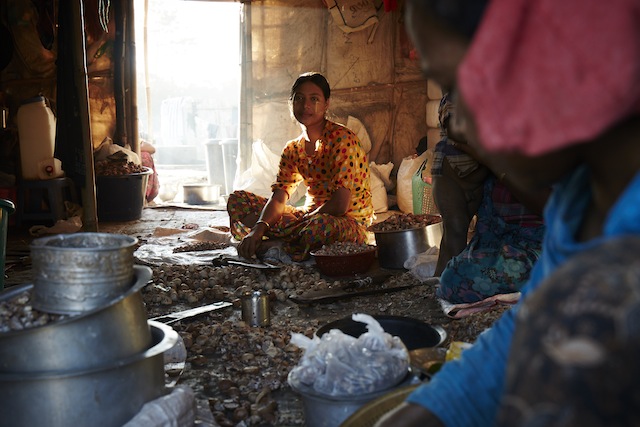 Farida, aged 18, works in her family's betel nut processing business. The nuts belong to Rakhine business owners, who pay the family less than 0.09 dollars per nut. Credit: Courtesy Rob Jarvis
Farida, aged 18, works in her family's betel nut processing business. The nuts belong to Rakhine business owners, who pay the family less than 0.09 dollars per nut. Credit: Courtesy Rob Jarvis
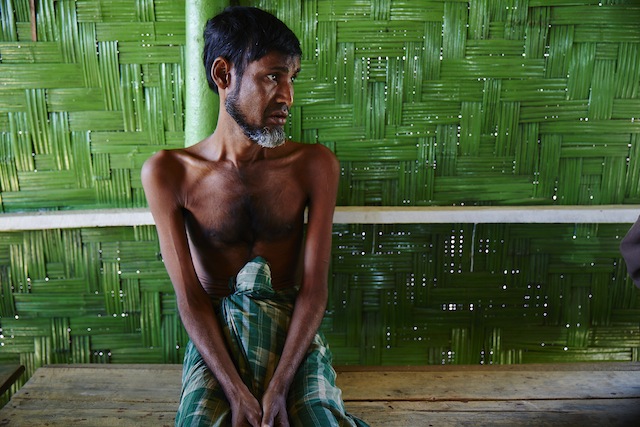 Abul Kasim, aged 53, a father of seven, finds it hard to explain what is wrong with him. He spends most of his days at the local clinic in Say Tha Ma Gee IDP camp, having not been able to eat properly, with severe bowel problems and internal bleeding for eight months. The clinic has referred him to Sittwe General Hospital but he says dares not go, and could not afford to in any case. Relying on traditional medicine, he has bouts of pain every day that leave him shaking uncontrollably. Credit: Courtesy Rob Jarvis
Abul Kasim, aged 53, a father of seven, finds it hard to explain what is wrong with him. He spends most of his days at the local clinic in Say Tha Ma Gee IDP camp, having not been able to eat properly, with severe bowel problems and internal bleeding for eight months. The clinic has referred him to Sittwe General Hospital but he says dares not go, and could not afford to in any case. Relying on traditional medicine, he has bouts of pain every day that leave him shaking uncontrollably. Credit: Courtesy Rob Jarvis
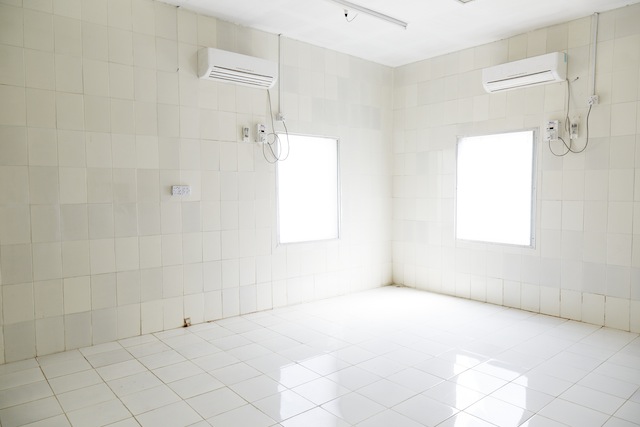 Da Naing clinic demonstrates the abject level of neglect faced by the IDP communities, as a result of aid mismanagement and the government's lack of care. The clinic was built by an international NGO in 2012 and has lain dormant for much of the time since. Though the government promised doctors and medicine, such provisions have been discontinued. Credit: Courtesy Rob Jarvis
Da Naing clinic demonstrates the abject level of neglect faced by the IDP communities, as a result of aid mismanagement and the government's lack of care. The clinic was built by an international NGO in 2012 and has lain dormant for much of the time since. Though the government promised doctors and medicine, such provisions have been discontinued. Credit: Courtesy Rob Jarvis
 Noor Jahan spends her days drying out and grinding chillies to help support her three children, mother-in-law, and out of work husband who used to be a labourer downtown where they are no longer allowed to travel. She buys the chillies fresh from the local market and then sells small affordable packets of 1-2 teaspoons worth, and is able to make just about two dollars in three or four days. Credit: Courtesy Rob Jarvis
Noor Jahan spends her days drying out and grinding chillies to help support her three children, mother-in-law, and out of work husband who used to be a labourer downtown where they are no longer allowed to travel. She buys the chillies fresh from the local market and then sells small affordable packets of 1-2 teaspoons worth, and is able to make just about two dollars in three or four days. Credit: Courtesy Rob Jarvis
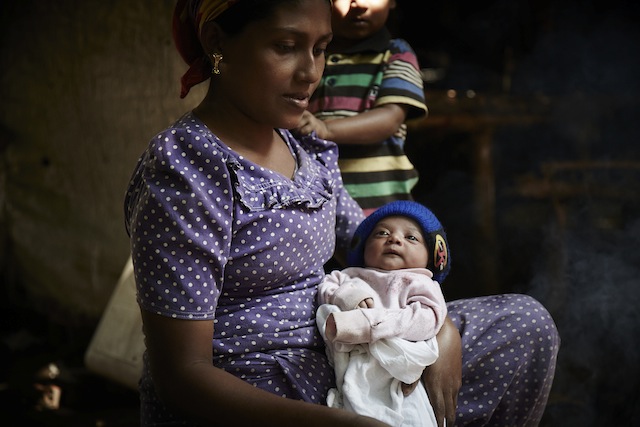 Mi Ni Ra, 16, is from Nasi village, which was burned to the ground during the violence in 2012. Her baby, just 16 days old here, was born in a small hut in Bu May IDP camp, outside Sittwe. Her baby was delivered traditionally in a small hut nearby, with the help of a local traditional birth attendant, without modern medical support. Credit: Courtesy Rob Jarvis
Mi Ni Ra, 16, is from Nasi village, which was burned to the ground during the violence in 2012. Her baby, just 16 days old here, was born in a small hut in Bu May IDP camp, outside Sittwe. Her baby was delivered traditionally in a small hut nearby, with the help of a local traditional birth attendant, without modern medical support. Credit: Courtesy Rob Jarvis
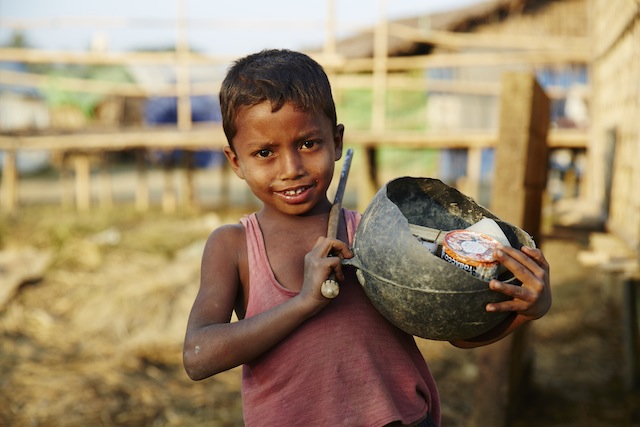 This boy spends his days selling betel nut in the traditional form, wrapped in a leaf with a bit of lime powder and tobacco. A salvaged halved buoy serves as his basket. Credit: Courtesy Rob Jarvis
This boy spends his days selling betel nut in the traditional form, wrapped in a leaf with a bit of lime powder and tobacco. A salvaged halved buoy serves as his basket. Credit: Courtesy Rob Jarvis
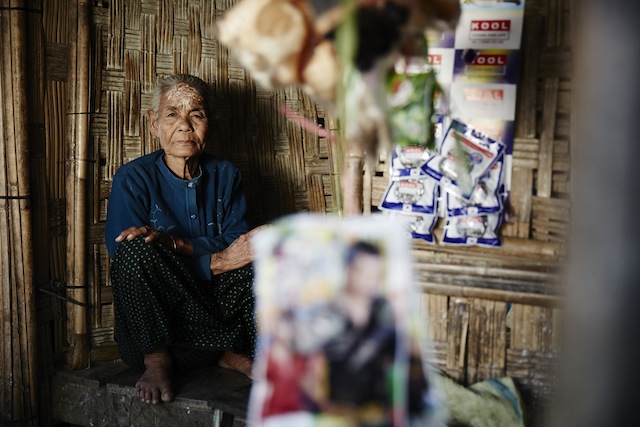 This elderly Rakhine woman has lived through independence and suffered as a member of a repressed minority under authoritarian rule by successive military regimes in Burma. After Rohingya Muslims burned her village in 2012, she has lived in an IDP camp outside Sittwe, where she struggled to save enough money to open this shop. Credit: Courtesy Rob Jarvis
This elderly Rakhine woman has lived through independence and suffered as a member of a repressed minority under authoritarian rule by successive military regimes in Burma. After Rohingya Muslims burned her village in 2012, she has lived in an IDP camp outside Sittwe, where she struggled to save enough money to open this shop. Credit: Courtesy Rob Jarvis
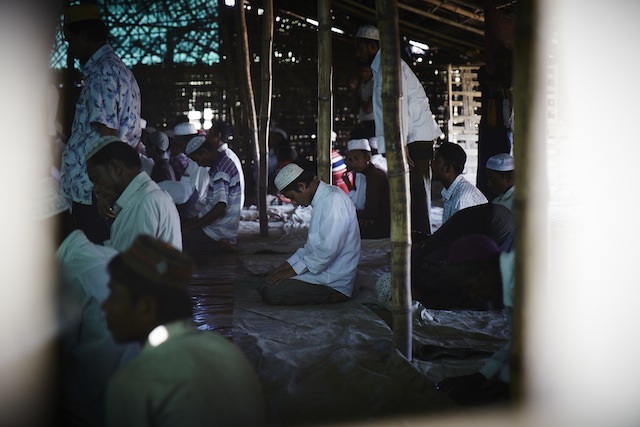 In the face of adversity, many of the displaced Muslims have turned to God, as instructed by their mullahs. These handmade bamboo mosques have been built in each IDP camp, with pump well washing facilities outside. Credit: Courtesy Rob Jarvis
In the face of adversity, many of the displaced Muslims have turned to God, as instructed by their mullahs. These handmade bamboo mosques have been built in each IDP camp, with pump well washing facilities outside. Credit: Courtesy Rob Jarvis
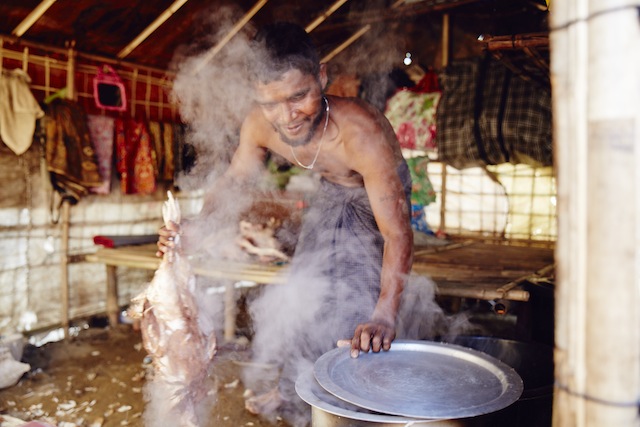 Angu Mia plucks and boils chickens for a female Rakhine business owner, who pays him 0.4 dollars per bird and then sells the meat at a local market. Credit: Courtesy Rob Jarvis
Angu Mia plucks and boils chickens for a female Rakhine business owner, who pays him 0.4 dollars per bird and then sells the meat at a local market. Credit: Courtesy Rob Jarvis
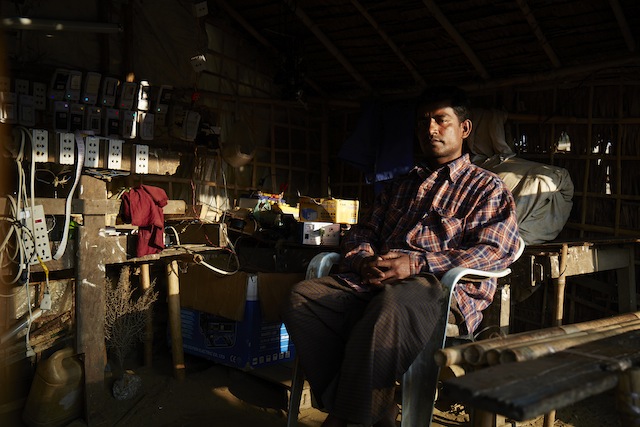 This man has installed solar panels to the top of his hut to provide a phone charging service to the minority of IDPs who have phones, as their huts have no power. Credit: Courtesy Rob Jarvis
This man has installed solar panels to the top of his hut to provide a phone charging service to the minority of IDPs who have phones, as their huts have no power. Credit: Courtesy Rob Jarvis
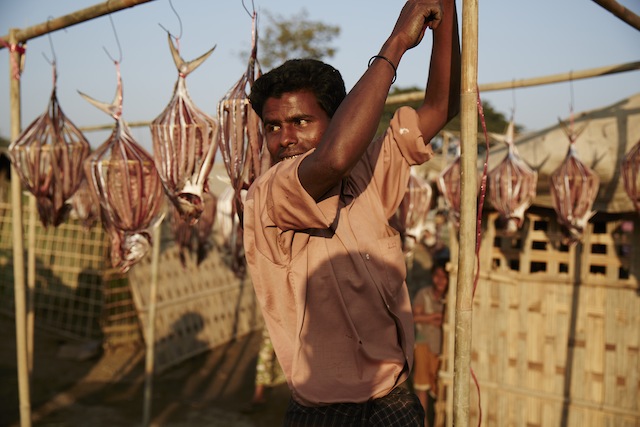 These pufferfish are dried and turned inside out to be sold to traders who take them to China. This man lost stocks of the product worth hundreds of dollars when his house was burned down in June 2012. He now leases fish from local fishermen, promising to pay them in full once he has made a sale. Credit: Courtesy Rob Jarvis
These pufferfish are dried and turned inside out to be sold to traders who take them to China. This man lost stocks of the product worth hundreds of dollars when his house was burned down in June 2012. He now leases fish from local fishermen, promising to pay them in full once he has made a sale. Credit: Courtesy Rob Jarvis
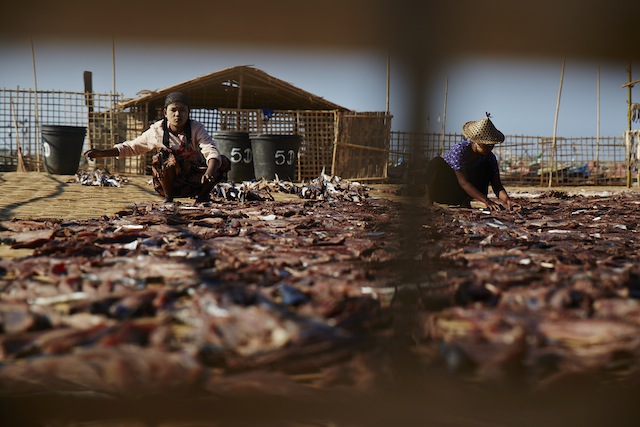 These women spend hours crouched in the sun on the seashore, drying out fish caught in previous days. Drying the fish preserves it for longer, making it more attractive locally, where a single fish will be eaten over days with small portions of rice. Large numbers of Rohingya Muslims from fishing communities in other parts of Rakhine State fled by boat when the violence began and came straight to this part of the coast, where the Rohingya Muslim communities have long run their fishing businesses. Credit: Courtesy Rob Jarvis
These women spend hours crouched in the sun on the seashore, drying out fish caught in previous days. Drying the fish preserves it for longer, making it more attractive locally, where a single fish will be eaten over days with small portions of rice. Large numbers of Rohingya Muslims from fishing communities in other parts of Rakhine State fled by boat when the violence began and came straight to this part of the coast, where the Rohingya Muslim communities have long run their fishing businesses. Credit: Courtesy Rob Jarvis
Edited by Kanya D'Almeida
Photos by Rob Jarvis: [email protected].
Text by Kim Jolliffe: [email protected]
© Inter Press Service (2015) — All Rights ReservedOriginal source: Inter Press Service
 Global Issues
Global Issues